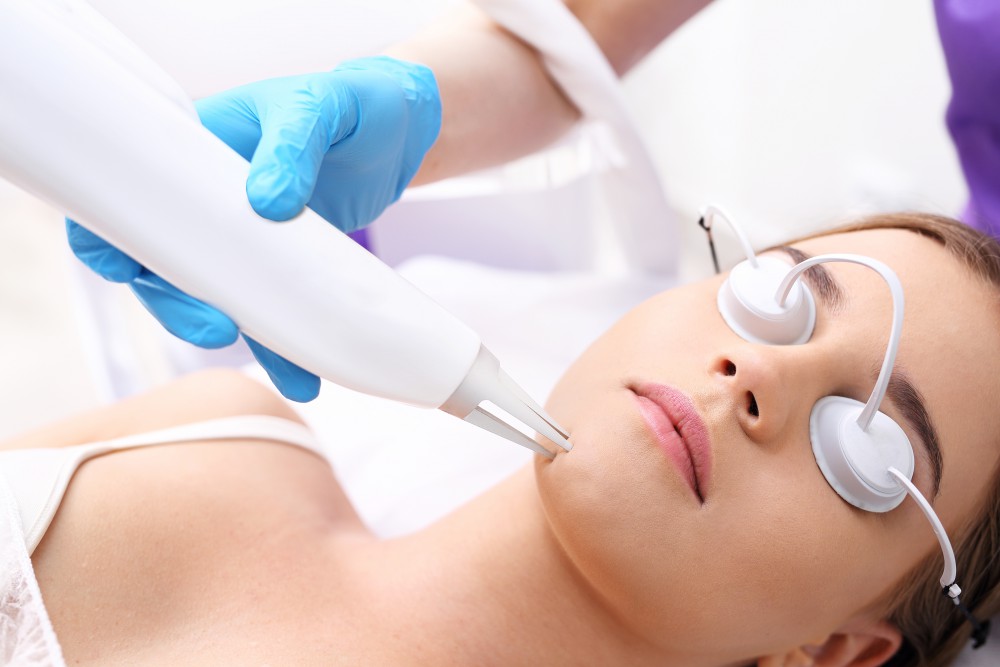
Daily water intake, consistent facials, and product overloads are no longer the only answers to ideal skin – lasers are. Whether your skin concerns are acne, wrinkles or discoloration, laser resurfacing is key in improving cosmetic flaws. Board-certified Dr. Shoib Myint sat down with Haute Beauty to discuss the many benefits of the new cutting-edge technology and what patients can expect when receiving this treatment.
What is a laser?
Laser stands for Light Amplification by Stimulated Emission of Radiation. Lasers work by producing an intense beam of bright light that travels in one direction. The laser beam can gently vaporize and/or ablate skin tissue to improve wrinkles, scars and blemishes, seal blood vessels or cut skin tissue. The laser has the unique ability to produce one specific color (wavelength) of light, which can be varied in its intensity and pulse duration. The newest laser systems have become remarkably precise and selective, allowing treatment results and safety levels not previously available.
What is skin resurfacing?
Laser resurfacing to improve cosmetic flaws, such as wrinkles, acne scars and aging and sun-damaged skin is the latest scientific breakthrough in skin rejuvenation.
Using a wand-like laser handpiece, undesired skin cells and wrinkles literally disappear in a puff of mist and are replaced by fresh skin cells. One of the laser’s most significant advantages over traditional techniques for skin resurfacing is that treatment is relatively bloodless. The procedure also offers more control in the depth of penetration of the skin’s surface, allowing an increased degree of precision and safety in treating delicate areas.
What conditions can laser resurfacing treat?
Laser resurfacing is performed to help:
- Erase fine lines and wrinkles of the face
- Smooth and tighten eyelid skin
- Improve crow’s feet around the eyes
- Soften pucker marks and frown lines
- Remove brown spots and splotchy, uneven skin color
- Improve and flatten scars
- Repair smoker’s lines
- Improve skin tone and texture
What can be expected during and after treatment?
Discomfort is usually minor during the procedure, and administration of any pain medication prior to treatment can be discussed for those who are very sensitive.
Following skin resurfacing, the treated areas usually are kept moist with ointment or surgical bandages for the first few days. The skin is typically red or pink and may be covered with a fine crust. The treated sites must be protected from sunlight after the procedure. Once healing is completed, sunblock lotion should be applied. In some cases, a pink surface color may remain for several days to several months. Make-up can be worn after about 7-14 days depending on the type of laser used.
Are there any side-effects or complications?
Each year thousands of laser resurfacing procedures are performed successfully. Significant complications are rare, and the risk of scarring is low. Some patients may be at risk for varying degrees of pigmentation loss, particularly with the CO2 laser. Common minor side effects may include crusting, mild swelling, redness or brown discoloration at the treatment sites. Risks of hyper-pigmenting can occur and should be discussed with your physician.
What are the limitations of laser resurfacing?
Laser resurfacing is not a substitute for a facelift, nor can the procedure eliminate excessive skin or jowls. However, by tightening loose skin, laser resurfacing can improve certain folds and creases. Laser resurfacing offers an alternative to traditional resurfacing methods like dermabrasion, and can also work well in conjunction with or as an additional treatment to other cosmetic skin procedures such as chemical peels, blepharoplasty (eyelid surgery) and liposuction of the face and neck.
How should patients prep for the treatment?
It is advisable to first and foremeost stay away from sunbathing or tanning few month before laser resurfacing. Sometimes a bleaching agent can be applied to lighten up the skin for better results. The lighter the skin the less risk of getting complications. Priming your skin to heal fast is the key, so anything you can do to increase your intake of greens and keeping your skin healthy and clean is vital to the outcome. This can be and should be discussed with your physician.
How soon can patients see results?
The results vary on a number of factors. Each patient is very different from another and the healing properties are deep rooted in your genetic blueprint, lifestyle, nutrition and environmental factors. Depending on the type of laser and treatment administered, healing can occur anywhere from 1-2 weeks to 4-6 weeks.
For more information, please visit www.drmyint.com
For more information, visit Dr. Brian A. Levine's social media:

























